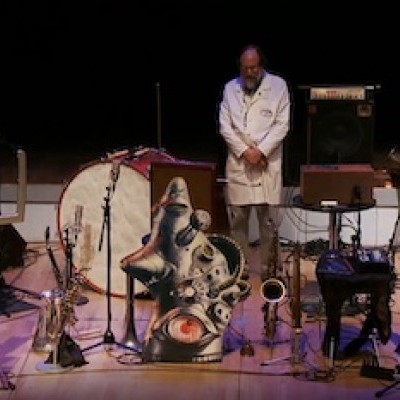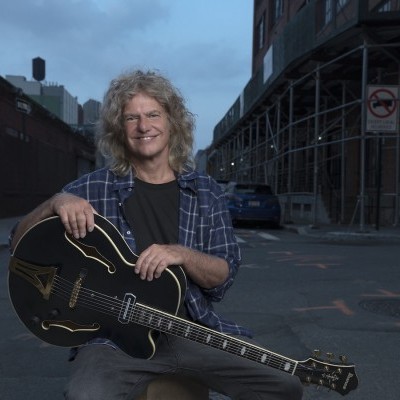Oct 28, 2025 10:47 AM
In Memoriam: Jack DeJohnette, 1942–2025
Jack DeJohnette, a bold and resourceful drummer and NEA Jazz Master who forged a unique vocabulary on the kit over his…
Radical changes in musical direction don’t always sit easily with listeners. The shock of the new can be convulsive. But in retrospect, these artistic schisms frequently provide important milestones. For example, consider the 1913 Paris debut of Igor Stravinsky’s The Rite Of Spring or Bob Dylan “going electric” at the 1965 Newport Folk Festival. Better yet, dig into Volume 6 of Columbia/Legacy Recordings’ Miles Davis “Bootleg” series: Miles Davis & John Coltrane—The Final Tour.
Recorded at five concerts during Davis’ spring 1960 tour of Europe, the 20 tracks showcase Coltrane’s final performances with a band in which he had been an integral member since 1955 (with the exception of a nine-month gap). Deep into what critic Ira Gitler called his “sheets of sound” period, Coltrane played long and hard—twisting melodic concepts and exploring harmonic combinations that would form the foundation of his next phase of musical development. Some members of the audience, particularly during the two shows on March 21 in Paris, made their objections known, while others clearly wanted to hear more.
“That wasn’t just a European thing,” said 89-year-old drummer Jimmy Cobb, the sole surviving member of Davis’ 1960 quintet, which also included pianist Wynton Kelly and bassist Paul Chambers. “A lot of places we played in the States before that tour weren’t ready for Trane’s thing, either. At one club, a woman stood up and yelled at Miles, ‘Make him stop.’”
Coltrane’s presence on the tour—a Norman Granz Jazz at the Philharmonic production that also included pianist Oscar Peterson and saxophonist Stan Getz—wasn’t guaranteed until just days before the entourage left for France. The Davis quintet’s previous gig had been in Oakland, California, on March 5, and Coltrane had already served notice. In fact, he had booked his new band into New York’s Jazz Gallery for May 3. (See sidebar on page 39.)
As jazz historian Ashley Kahn points out in his liner-notes essay, the 1960 tour represented a career breakthrough for Davis in Europe: It was his first trip to the continent leading his own band. Kahn writes that the trumpeter was “upgrading from the jazz club circuit in the U.S. to the level of international music star, playing major theaters in the capitals of Western Europe, appearing in tailored tuxedos ... .”
It was little wonder, then, that Coltrane’s potential departure gave him pause.
“Trane didn’t want to make the European trip and was ready to move out before we left,” Davis wrote in the autobiography he co-authored with Quincy Troupe in 1989. “If he had quit right then he would have really hung me up because nobody else knew the songs, and this tour was real important. He decided to go with us, but he grumbled and complained and sat by himself all the time we were over there.”
“[Coltrane] was there knowing it would be his last hurrah with the band,” Cobb recalled. “He only had one little airline bag with him, and not much but one extra white shirt. I don’t know if Miles had to beg him to do that tour or what, but he was all there onstage. We were having a great time. Everybody in that band could really play, and Miles let us play.”
While much of the focus on the music performed on the European tour—which has been previously peddled via inferior audio recordings on underground labels—has fallen on Coltrane because of his radical experiments and the audiences’ reactions to him, the entire band is in top form.
“Miles sounds amazing; he’s very energized,” said Michael Cuscuna, who co-produced The Final Tour box set along with Steve Berkowitz and Richard Seidel. “I don’t think Miles sounded this aggressive again until 1969.”
“Miles [is] very creative in his solos, and well-focused during the theme/exposition segments,” said Italian guitarist Enrico Merlin, who recently published the book Miles Davis 1959: A Day-By-Day Chronology. “In 1960, Miles was expressively as far from Kind Of Blue as Trane was.”
Cobb added, “You had to be strong enough to keep up with those guys. John wanted that support and interaction from a drummer, and I was young and strong then.”
The wild card for many first-time listeners likely will be Kelly, who had joined the band in early 1959. With the departure of alto saxophonist Cannonball Adderley in the fall of 1959, Kelly had already assumed a larger role as a soloist in the band. But during the winter of 1960, Davis had brought the band back up to a sextet with the addition of vibraphonist Buddy Montgomery. The younger brother of guitarist Wes Montgomery, Buddy had played some West Coast dates and was set to do the European tour, making it as far as the departure lounge at New York’s Idlewild Airport before his phobia of flying won out.
“So, because neither Adderley nor Montgomery are there, you get to hear a lot more Wynton Kelly,” Berkowitz said. “That’s a bonus, and I think fans will be thrilled to hear him playing his ass off.”
Cuscuna noted that Kelly’s exceptional playing at Copenhagen’s Tivolis Koncertsal on March 24 influenced the decision to include that show in the box set. The tracks from the Copenhagen show include “So What” and “All Blues,” both from the landmark Kind Of Blue.
The handful of opening shows on the tour featured long versions of Davis’ favorite live vehicles, including “On Green Dolphin Street,” “Walkin’,” “’Round Midnight” and “Oleo.” Kind Of Blue had been released in the States on Aug. 17 the previous year, but few copies had yet found their way into the hands of European fans. Although Davis was moving toward the use of musical modes as a harmonic framework for his compositions—introducing the Parisian audience to “So What” at the opening concert on March 21—he still favored tried-and-true pieces that the band had been playing live since the mid-’50s.
“Kind Of Blue was a spectacular moment in Miles’ career,” said Merlin, “but the sextet [with Adderley] never played like that live. There was a great dichotomy between live and studio playing, whether it was Red Garland, Bill Evans or Wynton Kelly on piano, and Philly Joe Jones or Jimmy Cobb on drums.”
As Kahn writes, on the 1960 tour, Davis was “staking a stylistic middle ground between, on the one hand, the familiar standards of the 1940s and ’50s—‘Bye Bye Blackbird,’ ‘On Green Dolphin Street,’ ‘All Of You’—[and] new, open-ended structures with an emotionally ambivalent effect—‘So What,’ ‘All Blues’—modal compositions demanding a focus on personal lyricism.”
Kahn speculates that it was the crowd’s vociferous reaction to Coltrane’s unexpected extrapolations of the standards that influenced Davis’ decision to include more of the modal work on the later shows.
“What Miles picks for his set list is always fascinating to study,” Cuscuna said. “Certainly what we see here shows a trajectory away from the standards toward the modality of Kind Of Blue, with Coltrane working out his own steeplechase harmonics through the music.”
As new and challenging as it was, the outspoken audience members, who can be heard whistling or shouting, were in the minority. Following a show, Swedish pianist Lasse Werner (1934–’92) praised the band in a review he penned: “They showed the listeners the confidence never to resign and just play the known and safe phrases, and they invited us to be part of a creative process in which everything can happen.”
Selecting representative shows from among those played in 20 cities—which included Oslo, Berlin, Stuttgart and Milan—was a challenge for the three producers. Several shows were recorded by state-owned broadcasters, and as the number of bootlegs that have appeared over the years illustrate, there is no shortage of unauthorized audience recordings.
“We knew Paris and Stockholm were the strongest, from both the sound and performance basis,” Cuscuna said. “I also felt Copenhagen was outstanding, but there was a phasing problem with the sound, so we had to get it to a point where it stood up to the others.”
“I’ve had a high-resolution copy of the Paris shows for years, so I knew that was rock-solid,” Berkowitz said. “I also knew there was a quarter-inch tape that was made the day of the Copenhagen show, but the question was, how could I get my hands on it?”
The quest for a usable version of that Copenhagen show is the stuff of record collectors’ fantasies, even while it belies the image of how a major international corporation like Sony Music might work. It began with a call to a former executive with Sony Europe, which led into the depths of the bureaucracy of the Netherlands’ public radio system. Officials there told Berkowitz that all that existed of the quintet’s performance was a DAT copy. Berkowitz persisted, convinced of the presence of a source tape.
“Several weeks went by, and the date for mastering the set was coming up fast,” Berkowitz recalled. “Finally, the week before our deadline, we discovered the Dutch radio people were confusing what we were looking for with a radio documentary that had been done on Miles. They had been looking for the wrong thing.”
On the Thursday prior to mastering, Berkowitz finally received a photo of the source tape. He located an engineer in the Netherlands who could do a digital transfer of the tape and dispatched a bicycle courier to pick up the tape and deliver it to the engineer’s remote studio.
“I went to bed that night with the image of the bike courier frantically pedalling out into the woods to deliver that historic tape,” Berkowitz said.
On Saturday night, with just days to spare, the digital file arrived.
So now, Berkowitz, Cuscuna and Seidel had five shows—close to four hours of music—along with a six-minute interview with Coltrane, conducted by saxophonist Carl-Erik Lindgren. Why stop there when recordings of other shows exist, like the March 22 Stockholm concert and the April 8 gig in Zurich?
“There are commercial considerations in creating sets like these today,” Berkowitz said. “These are the shows that were the best quality. You get to hear the acceptance and non-acceptance by the audience, and you hear the band take things pretty out in Paris and Stockholm. It’s a pretty concise size.”
“My goal is to legitimize this music and get it out to regular jazz fans who may never have heard this,” Cuscuna said. “This gets this amazing music out to beyond what I call the ‘cassette crowd’—fanatics who have always collected music like this, trading it from hand to hand.”
For vinyl collectors and audiophiles, Columbia/Legacy will release a single 12-inch album of the Copenhagen concert, and a two-LP edition of the Paris concerts will be released by Vinyl Me, Please on 180-gram vinyl with special listening notes.
“The vinyl sounds fantastic, and we really wanted to get this out to younger people who are so into vinyl now,” Berkowitz said.
For Berkowitz—an enthusiastic music veteran who has worked with artists as diverse as Leonard Cohen and Henry Threadgill—the music Davis’ quintet made during those three weeks in 1960 has another gift for young listeners.
“Here you have two of the century’s giant thinkers, doing what they do best. They’re coming together and diverging. They’re together and untogether. In this binary era, when people seem to be for or against things, we all could use this display of different minds working together to create something beautiful.”
“What you hear,” said Cuscuna, “is a band at the end of its run, and you hear this genius, Coltrane, breaking out and moving on.” DB

Jack DeJohnette boasted a musical resume that was as long as it was fearsome.
Oct 28, 2025 10:47 AM
Jack DeJohnette, a bold and resourceful drummer and NEA Jazz Master who forged a unique vocabulary on the kit over his…

Don and Maureen Sickler serve as the keepers of engineer Rudy Van Gelder’s flame at Van Gelder Studio, perhaps the most famous recording studio in jazz history.
Sep 3, 2025 12:02 PM
On the last Sunday of 2024, in the control room of Van Gelder Studio, Don and Maureen Sickler, co-owners since Rudy Van…

Trio aRT with its avalanche of instrumentation: from left, Pheeroan akLaff, Scott Robinson and Julian Thayer.
Sep 3, 2025 12:03 PM
Trio aRT, a working unit since 1988, shockingly released its very first studio recording this summer. Recorded in…

“Think of all the creative people I’m going to meet and a whole other way of thinking about music and a challenge of singing completely different material than I would have sung otherwise to my highest level in dedication to the moment,” Elling says about his Broadway run.
Sep 9, 2025 1:18 PM
Kurt Elling was back at home in Chicago, grabbing some family time in a late-June window between gigs. Sporting a smile…

Pat Metheny will perform with his Side-Eye III ensemble at Big Ears 2026 in Knoxville, Tennessee, next March.
Sep 9, 2025 12:19 PM
Big Ears has announced the lineup for its 2026 festival, which will take place March 26–29 and include 250…